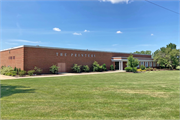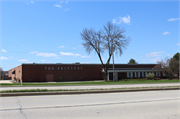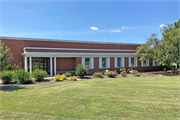| Additional Information: | 2023: The E.P. Hoyer Building, is a one-story, commercial building constructed c. 1966. The building was most recently occupied by the Printery, an RR Donnelley company. It is a vernacular brick building with a rectangular footprint and flat roof. A rectangular extension across the east half of the façade (east elevation) features modest classical details, including Doric columns supporting the flat roof over the recessed entrance, a projected cornice at the base of the parapet wall, six evenly spaced, eight-over-twelve, double hung windows with fixed shutters, and decorative brick quoins at the corners of the building. Large letters centered across the west half of the façade read “THE PRINTERY.” There is also a secondary entrance on the west half of the façade. The building faces east toward Moorland Road and there is a small parking lot directly north that is accessed from Overland Drive.
The building is one of the first constructed as part of the New Berlin Industrial Park. The New Berlin Industrial Park was the vision of Mayor Earl E. Rathke. Under Rathke, the city began purchasing land for the industrial park in 1964 and eventually acquired 620 acres, making it the largest industrial land bank in the Midwest at that time. The common council developed 13 restrictions for construction within the Park. The restrictions included guidelines on setbacks, lot arrangements, façade materials, building designs, and parking lots, all in an effort to maintain a park-like feeling. Although it was feared that the restrictions would deter potential developers, 47 businesses had purchased land within the park by 1967, 18 of which had completed buildings and 9 which had started construction. The Park played an important role in turning the small farming town of New Berlin into a suburban industrial center, on the outskirts of the City of Milwaukee.
The Park is bounded by Cleveland Avenue on the south, Calhoun Road on the west, the Union Pacific Railroad on the north, and Moorland Road on the east. Buildings within the Park are primarily one- and two-story, rectangular buildings, with flat roofs, and masonry exteriors. Most of the buildings are representations of Contemporary style commercial architecture, with a few exhibiting classical architectural embellishments. Common alterations include façade reconfiguration, exterior recladding, window replacement, and warehouse additions. |
|---|



